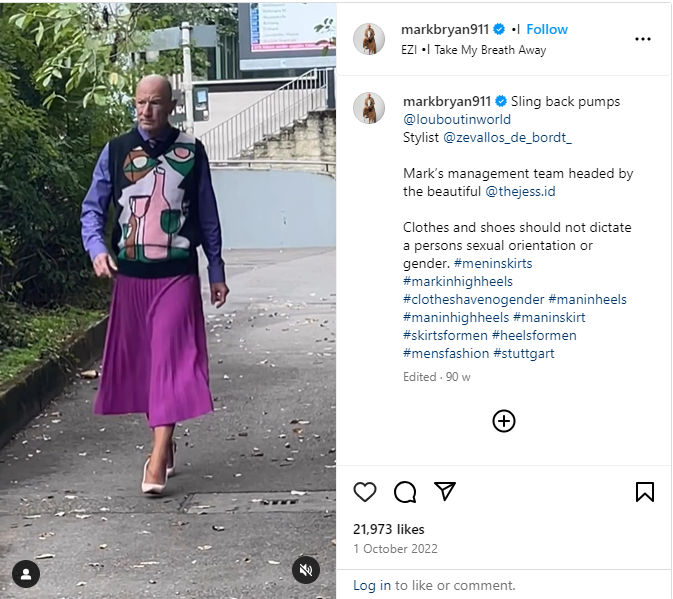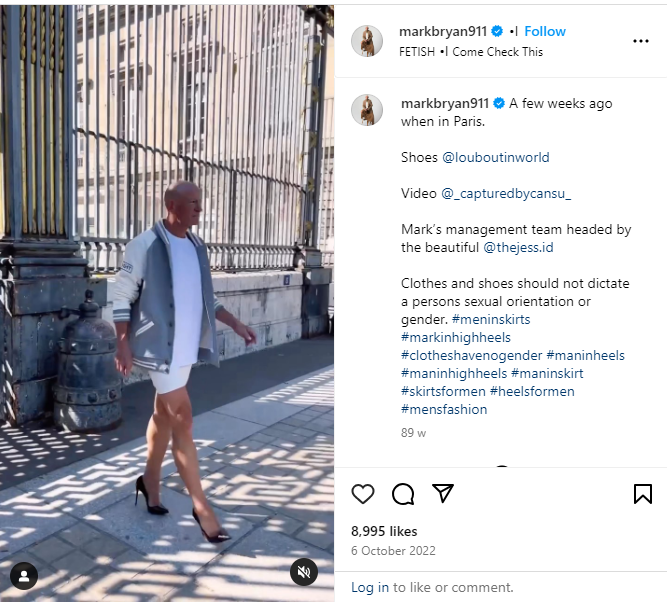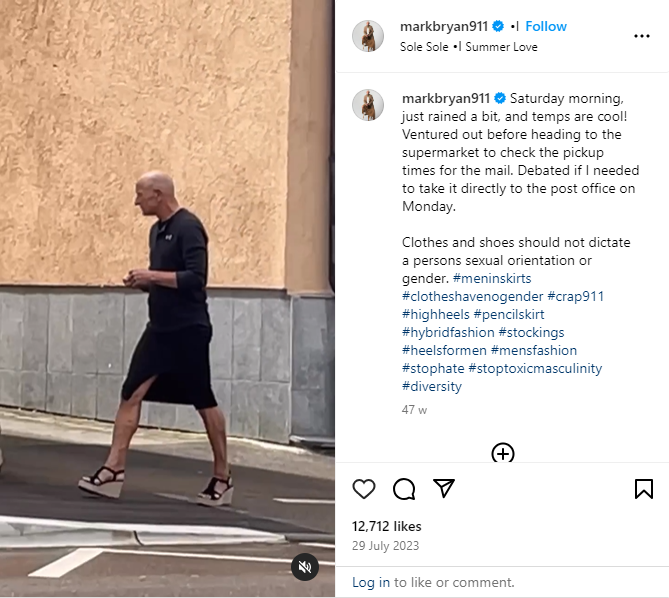
Mark Bryan is a robotics engineer who has been married for 11 years and has a daughter. He identifies as straight and chooses to dress unconventionally. Bryan is an American living in Germany, and he doesn’t believe that fashion has to be gendered. You can find Bryan wearing a skirt and heels to work or out anywhere else he goes on any given day.
Bryan said he doesn’t like how limited men’s choices are in the fashion department, especially when it comes to office attire. Men’s pants only come in a few colors, mostly black, gray, dark blue and the occasional pinstripe, and cuts.
The stylish dresser believes that if women are allowed to wear pants, men should be able to wear skirts and dresses as well. Bryan likes how skirts come in many styles and patterns – and many more colors – unlike men’s clothing.

Bryan prefers to mix traditional gender looks by wearing masculine attire on his top half, like a blazer and tie, and traditionally feminine attire on the bottom half. He will typically wear a pencil skirt and four-inch heels on the bottom.
Wearing high heels is no problem for Bryan. He first learned how to do it when his college girlfriend asked him to wear high heels while dancing with her so that they were on the same level. They continued this for over a year.
Bryan doesn’t let stereotypes or assumptions stop him from dressing in a way that brings him joy. He challenges expectations and does so unapologetically. Keep reading to hear what Bryan has to say about his fashion choices.
Bryan has a very clear idea about how he likes to dress. He told Bored Panda: “To me, clothes have no gender. I prefer skirts to dresses. Dresses don’t allow me to mix the genders. I prefer a ‘masculine’ look above the waist and a non-gendered look below the waist. It’s all about clothes having no gender.”
He continued: “I am old enough to remember that in school, the girls could not wear pants. Pants have now become a non-gendered article of clothing. So why can’t skirts and heels be non-gendered? Besides, men wore heels before women did. Maybe not today’s stiletto-style heels, but men did wear heels before women.”

Bryan is correct about that. High heels can look back on a long history. Although historians and archaeologists cannot date their invention clearly, they have been around at least since the 10th century. And they were not a fashion statement at first. No, the first recorded use of high heels was eminently practical: the Persian cavalry wore boots with heels, called a kalash or galesh, that made it easier for them to keep their feet inside their stirrups. This is, by the way, the same reason why cowboy boots have a small heel as well!
Since owning a horse was a sign of wealth, only well-off men could afford to wear these high-heeled boots. The use of them slowly spread across Europe, and high heels heels became one of the fashion signs of rich noblemen or traders. In fact, following the Great Schism of the Christian Church in the 11th century, even the pope wore high heels.
It wasn’t until several hundred years later that fashion slowly changed. During the 18th century, cultural concerns in Europe came up about the distinction between males and females and talk about what men and women should wear arose. This is the point in time where the belief that fashion is something effeminate and frivolous that “real men” shouldn’t care about hails from. Due to these changing beliefs, men largely abandoned high heels heels, as they were seen as impractical and mere accessories.

Bryan is one of the examples of how high-heels are slowly coming back as an accepted form of footwear for men. Although the engineer champions the option of wearing high-heeled shoes for men, he understands many people will look twice when they see him. He compares his style choices to someone who chooses to dye their hair bright colors. He explained:
“Take a person with bright green hair. Green hair is not normal. You look up and see this person, your mind tells you it’s a person with green hair, you think to yourself, that’s odd or interesting, then you go back to do what you were doing and don’t give it another thought. I believe this is the same when people see me in a skirt and heels.”
Bryan doesn’t have to struggle to find skirts and heels that fit him either. He wears a size 8 in skirts, and with smaller feet for a man, his shoe size in heels is 8.5. If you know a man who is considering trying out wearing heels and skirts too, Bryan suggests starting with a lower heel until you feel more comfortable walking in high heels.
What do you think of Mark Bryan’s style choices? Do you know any men who would try walking in high heels? Let us know, and be sure to send this along to your friends and family.
JD Vance is under fire as a ‘hypocrite’ after drag photos from his college days come to light

While Ohio Senator JD Vance (R) remains silent on the newly emerged drag photos, former Rep. George Santos has been vocal on the matter.
On Sunday, a photo of the Republican vice presidential nominee in a blonde wig and a long dress went viral, drawing attention due to its clash with the GOP’s frequent stance against drag and LGBTQ+ rights.
The photos that caused a stir on the social media were posted on X by Matt Bernstein with the caption, “new: i have obtained a photo of jd vance in drag while at yale law school.”

The authenticity of the photos was confirmed by Travis Whitfill, who provided them, stating, “This was taken in 2012… Photo was taken by a classmate and sent to me.”

As expected, people reacted to the photo, with one person writing, “Ladies and gentleman, a picture of JD Vance in drag while attending Yale Law School. I don’t share this to shame those who do drag, but rather to shame those who attack drag while having a history of enjoying the art form themselves.” Someone else commented: “Feelin’ cute. Might run for Vice President later.” A third added: “Don’t call JD Vance weird because he wore drag. Call him a hypocrite and a bigot for demonizing others who wear drag.”
There were also those who stood for Vance, including Republican U.S. representative from New York George Santos who said Vance’s photos were more of a goofy costume from a college house party than drag, as reported by TMZ.
“To call that drag is disingenuous and I think most dudes at some point in their lives have played around with costumes that are gender bender. Couples do that all the time. The wife will dress up as a guy, the husband will dress up as a woman. It’s definitely not drag,” Santos said.
Please SHARE this article with your family and friends on Facebook.



Leave a Reply